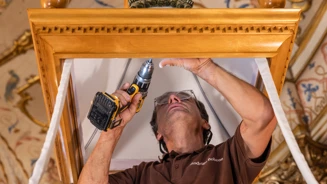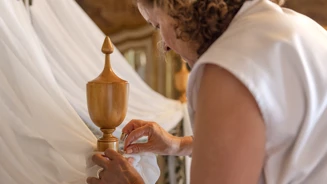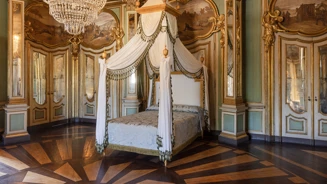National Palace of Queluz breathes new life into the deathbed of King Pedro IV
24 Sept 2025
Almost two hundred years after the death of King Pedro IV of Portugal and first Emperor of Brazil, in the Don Quixote Room of the National Palace of Queluz — where he had been born 35 years earlier — the space, imbued with his memory, continues to stir deep emotion among those who visit it. From today, 24 September, the anniversary of the monarch’s passing in 1834, a unique reconstruction of the state bed on which the event took place will bring visitors even closer to the revolutionary figure who brought an end to the Ancien Régime and opened Portugal to the new winds of Liberalism.
According to João Sousa Rego, Chair of the Board of Administrators of Parques de Sintra, ‘The aim of this project is to allow for a more accurate interpretation of the Don Quixote Room, so strongly linked to the life and death of King Pedro IV, one of the monarchs who indelibly marked the history of the National Palace of Queluz, of Portugal, and of Brazil. This bed is not merely a piece of furniture; it is a symbol of a moment that changed Portugal forever. For this reason, its reinstatement in this space enriches the curatorial narrative of the monument, fully aligned with the company’s mission.’
João Sousa Rego emphasised that ‘the historically informed reconstruction of the state bed required extensive research, followed by a meticulous process involving expert carpenters and seamstresses to obtain the version closest possible to the original, using the same type of wood and fabrics described in the studied inventories. This project embodies one of the three guiding principles of Parques de Sintra’s mission — offering a distinctive cultural and touristic experience that enriches visitors and authentically enhances heritage — demonstrating how historical research, conservation and traditional craftsmanship can restore key elements of our collective memory.’
The death of King Pedro IV: the political act that ended the Ancien Régime
In 1834, gravely ill, Pedro de Alcântara—former King of Portugal and first Emperor of Brazil—chose the Don Quixote Room of the Palace of Queluz as the setting for his death and his final political act. After triumphing in the civil war against the Absolutists led by his brother, Miguel, he had established Liberalism in Portugal. Yet, at the moment of departing this world, he requested to be taken, strategically, to the very bastion of the Ancien Régime where he had been born. At his side in his final hours were his wife, Amelia of Leuchtenberg, the young Queen Maria II, Princess Maria Amélia, the Dukes of Terceira and Saldanha, his aides-de-camp, personal servants, and Father Marcos, his confessor.
The purpose behind this decision — as we now understand — was fully achieved: with his passing, the chapter of Absolutism in Portuguese history was definitively closed. His memory became so intertwined with the Palace of Queluz that the place was never the same again. The Don Quixote Room became a kind of sanctuary, and the state bed on which he drew his last breath acquired great symbolic value, preserved as a historical relic.
The new regime sought to safeguard King Pedro IV’s legacy as the ‘liberator’ of the nation, and so the Don Quixote Room retained the appearance of a bedchamber it had been given in 1834—dominated by that same bed—and it was never again used by subsequent monarchs, who chose to keep their distance from Queluz.
The room was mentioned by several distinguished visitors to Portugal, such as Prince Felix Lichnowsky of Prussia and the English traveller Dora Wordsworth. Yet the most moving account came from Princess Maria Amélia, King Pedro IV’s youngest daughter, who also died young from tuberculosis. In a letter dated 27 August 1851, she recalled one of her visits to Queluz: After my father’s death, I never again saw that palace. I remembered nothing—absolutely nothing—except the room where my father died!... There, I remembered everything. Each object is engraved in my memory, though I was only three years old at the time! It was with great emotion that I entered that room!... The bed... the bed is still the same, in the same place, adorned with the same curtains; the same bedcovers, the same pillows... all well preserved... Ah...
A historical relic lost — and now reborn
On the night of 4 to 5 October 1934, during extensive restoration works undertaken to prepare the permanent public opening of the Palace of Queluz, a fire broke out that seriously damaged part of the building, particularly the wing housing the Don Quixote Room. Although much of the furniture from the palace was saved, King Pedro IV’s bed did not survive. It was replaced by another canopy bed from the former royal collections, which remained there until now.
In 2022, the symbolic importance of this piece led Parques de Sintra to launch a research project to bring the Soldier-King’s deathbed back to life. Existing iconography — such as the 1850 watercolour by Ferdinand Le Feubure and period photographs — provided valuable information regarding both the wooden structure and the textile framework, including the bedcover, the upholstered headboard and the canopy with its ornamental fringe. Descriptions found in inventories compiled after King Pedro IV’s death (1851, c. 1874, 1908-1910) offered valuable detail about the materials used, such as hawthorn wood for the bedstead, blue damask silk for the bedcover, and white embroidered muslin for the canopy, whose fringe featured green and white tassels. Two of these inventories also recorded the dimensions of certain textile elements, providing significant guidance for the project.
Given the specific nature of the components involved, Parques de Sintra’s conservators divided the project into two distinct areas. On the one hand, the construction of the hawthorn-wood frame, as indicated in the inventories, was entrusted to a craftsman experienced in classical furniture, who produced the technical drawings and built the structure. At the same time, a specialist atelier in sewing/decoration recreated the textile elements with precision, using the same fabrics mentioned in the inventories.
The result of this three-year endeavour can now be admired by visitors to the Don Quixote Room of the National Palace of Queluz. Situated within the wing of the royal private chambers built in the second half of the eighteenth century to the design of French architect Jean Baptiste Robillion, this room, decorated with rococo and neoclassical motifs, takes its name from the paintings depicting scenes from Cervantes’ Don Quixote de la Mancha that adorn the cornice and overdoors. Over the years, the space has served various purposes, yet the memory of King Pedro IV’s death remains its most enduring legacy.



